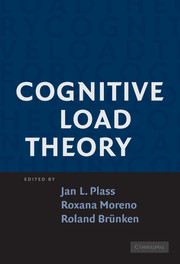Book contents
- Frontmatter
- Contents
- Contributors
- COGNITIVE LOAD THEORY
- Introduction
- PART ONE THEORY
- PART TWO EMPIRICAL EVIDENCE
- 5 Learning from Worked-Out Examples and Problem Solving
- 6 Instructional Control of Cognitive Load in the Design of Complex Learning Environments
- 7 Techniques That Reduce Extraneous Cognitive Load and Manage Intrinsic Cognitive Load during Multimedia Learning
- 8 Techniques That Increase Generative Processing in Multimedia Learning: Open Questions for Cognitive Load Research
- PART THREE DISCUSSION
- Index
- References
8 - Techniques That Increase Generative Processing in Multimedia Learning: Open Questions for Cognitive Load Research
Published online by Cambridge University Press: 05 June 2012
- Frontmatter
- Contents
- Contributors
- COGNITIVE LOAD THEORY
- Introduction
- PART ONE THEORY
- PART TWO EMPIRICAL EVIDENCE
- 5 Learning from Worked-Out Examples and Problem Solving
- 6 Instructional Control of Cognitive Load in the Design of Complex Learning Environments
- 7 Techniques That Reduce Extraneous Cognitive Load and Manage Intrinsic Cognitive Load during Multimedia Learning
- 8 Techniques That Increase Generative Processing in Multimedia Learning: Open Questions for Cognitive Load Research
- PART THREE DISCUSSION
- Index
- References
Summary
In Chapter 7, we defined multimedia learning, described how people learn from verbal and pictorial information according to the Cognitive Theory of Multimedia Learning (CTML; Mayer, 2005), and examined the relationship between CTML and cognitive load theory (CLT; Sweller, 1999). Specifically, we offered a triarchic theory of cognitive load according to which there are three kinds of cognitive processing demands during learning: extraneous, essential, and generative. We defined extraneous processing as the cognitive processes that are not necessary for making sense of the new information, essential processing as the cognitive processes that are required to mentally select the new information that is represented in working memory, and generative processing as the processes of mentally organizing the new information into a coherent structure and integrating the new knowledge representations with prior knowledge.
As explained in the previous chapter, the different nature of the three cognitive demands suggests three goals for the design of multimedia learning environments, namely, to reduce extraneous cognitive processing, to help students manage essential cognitive processing, and to foster generative processing. In the present chapter, we focus on the third of these goals by reviewing techniques that are aimed at increasing generative processing in multimedia learning. As in Chapter 7, the methods reviewed in the present chapter have been distilled from the research program of the authors, which is aimed at better understanding how aspects of media design correspond to the cognitive processes that affect knowledge acquisition.
- Type
- Chapter
- Information
- Cognitive Load Theory , pp. 153 - 178Publisher: Cambridge University PressPrint publication year: 2010
References
- 17
- Cited by

